Preservation scene in the 1960s
Posted by Chris Graham on 22nd June 2020
Clive Baker recalls the emerging preservation scene in the 1960s, with some pictures of Staffordshire rallies he visited.
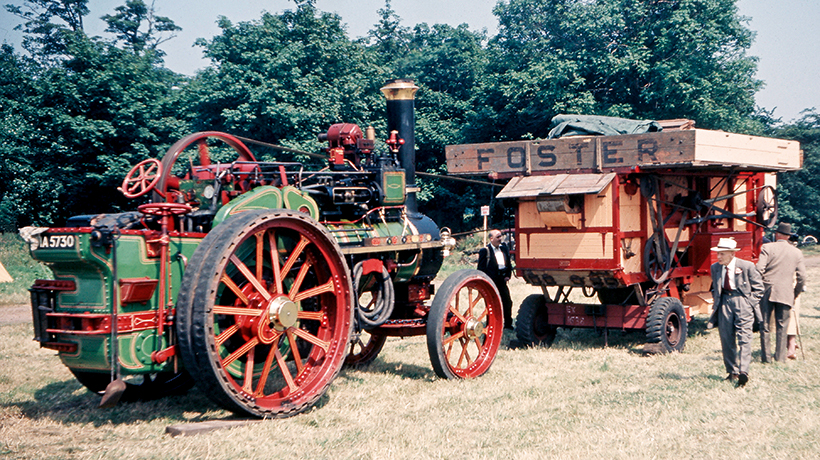
Preservation scene in the 1960s: A threshing set seen at the Colton rally in 1965. Supplied by William Foster & Co to Bonnel, Audlem in 1910, the engine (MA 5730) was sold to Barlow, High Leigh in 1914. Judging by its pneumatic tyres, the threshing box could possibly have still been in general use at that time. The smartly-attired gentleman in suit, tie and straw hat observing operations, could no doubt recall witnessing steam threshing before the days of preservation.
Throughout my schooldays, railways remained prominent among my transport interests; the whole operation of the system fascinating me to the extent that, at any time away from studies, I could be found – with notebook – by the side of one of the rail routes that came quite close to my home. However, the aspect of the railway that lured me the most had to be the steam locomotives; a form of traction that by 1963 – the year I left school – was dwindling in numbers. Those magnificent machines from the Victorian age were making way for diesel and electric equivalents, so I needed to find an alternative interest.
During his boyhood, my father had become fascinated by traction engines and would, on many occasions, relate to me how his enthusiasm would grow every year as the local, ‘Statutes Fair’ drew near; a time when he could wander among the showman’s engines, as they hauled the various amusements into the market square of our home town.
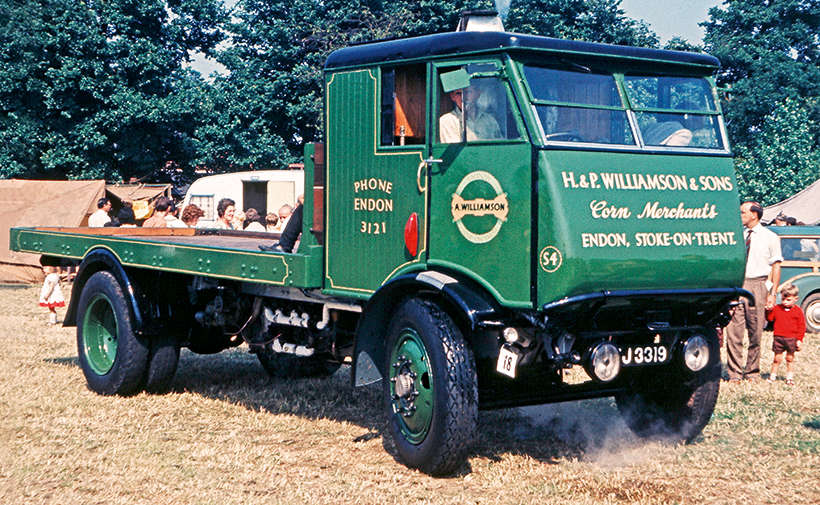
Sentinel S4 type steam wagon, TJ 3319, at Colton in 1965. Supplied in 1933, this was the first model by the manufacturer to feature a shaft-drive as opposed to chain. This vehicle is still to be seen at rallies, in largely the same livery.
Having been introduced briefly to the newly-emerging traction engine rallies featured in journals, among them the pages of the Meccano Magazine, I decided to pay a visit to such an event. It was accessible by bicycle from my home, and took place in a field at Colton, a village close to Rugeley, in Staffordshire. This was a very rural gathering, with basic facilities and no razzmatazz at the venue which had one boundary running alongside the Trent Valley railway line. I remember visiting this event in July 1963, then again – with a better camera – in 1965. On both occasions, the weather could be described as glorious and attendance were high.
I recall observing a mix of agricultural and road haulage steam engines, including rollers, portable boilers, plus lorries from both Sentinel and Foden and one showman’s engine. Built by Burrell in 1913 and named ‘Rajah’, the engine came complete with a 48-key, Veerbeck fairground organ.
In particular, a working threshing set attracted my attention. It was belt driven from a Foster agricultural engine of 1910, and traditional threshing could be demonstrated incorporating a threshing box which, because it was fitted with pneumatic tyres, was likely to be in commercial use at that time. I’d seen similar equipment in action on a farm before, but with traction supplied by a Fordson, diesel-powered tractor.
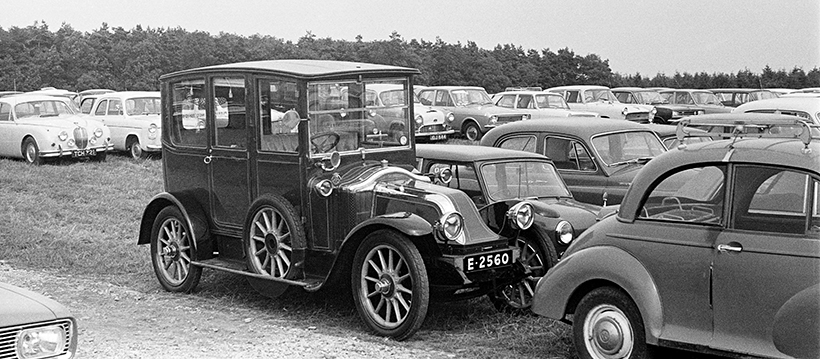
An unusual sight; a 1904 Renault registered E 2560, parked among models concurrent with the motoring scene of 1969, and dwarfing the neighbouring Mini. The bulkhead-mounted radiator, positioned behind the ‘coal scuttle’ bonnet, designed by Renault, proved to be a very difficult item to manufacture. The body, produced by an unknown supplier, would have been ordered separately.
Another very impressive exhibit presented itself in the form of a Sentinel S4-type steam wagon of 1933; being the first such machine to be shaft-driven as opposed to chain, this marque set new standards in steam road haulage.
On a sunny afternoon, with the aroma of hot oil in the air, plenty of smoke and sounds from an array of steam whistles, I couldn’t fail to notice the frequent passage of trains along the neighbouring railway line. In particular, these included some once top-link express steam locomotives, in a most neglected condition, reduced to hauling freight workings – a total contrast to the immaculate and cared-for state of the road machines which I’d specifically cycled some distance to see.
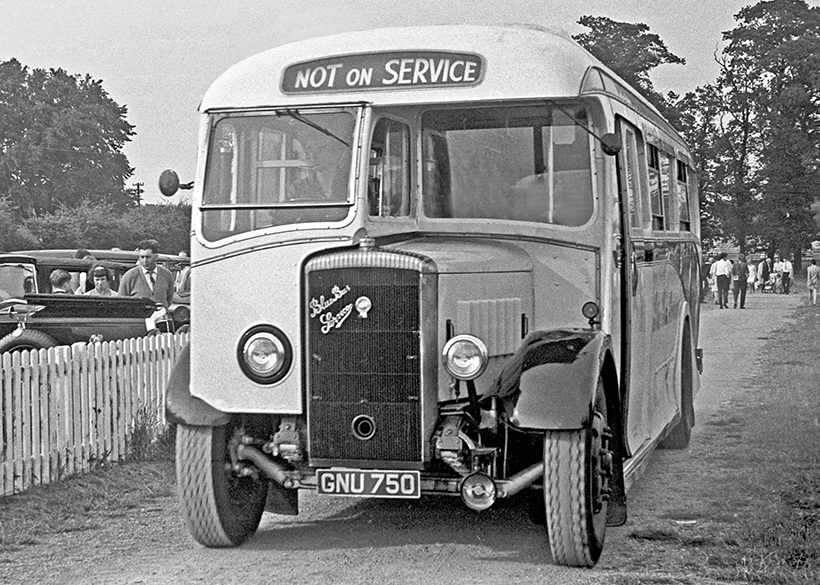
While watching the parade, the entry into the ring of Daimler COG5/40, GNU 750, of 1939, instantly stirred memories for me of travelling on and observing the Blue Bus Services that operated two routes between Burton upon Trent and Derby. Its owner from new until disposal, in 1965, had kept this bus in immaculate condition, generally operating it on private hire and tour duties. My last sighting of her in revenue-earning service had been in 1965, so seeing ‘DR5’ (Daimler 5, in Blue Bus terms) preserved to such a high standard was heart-warming, to say the least.
A move to Stafford
I will always enjoy witnessing steam-powered road transport but, by the late 1960s, I’d begun to take a greater interest in buses. However, on noting that, by 1969, what had once been the Colton rally had moved to a new venue at the Stafford Showground. So, I decided to pay the event a visit and, by this time, I’d graduated to a Morris 1000.
While walking through the rows of parked cars towards the entrance, a time-warp sight presented itself – parked next to and dwarfing a Mini, was locally-registered (E 2560) was a 1904 Renault with bulkhead-mounted radiator. Its engine specification and body builder are unknown.
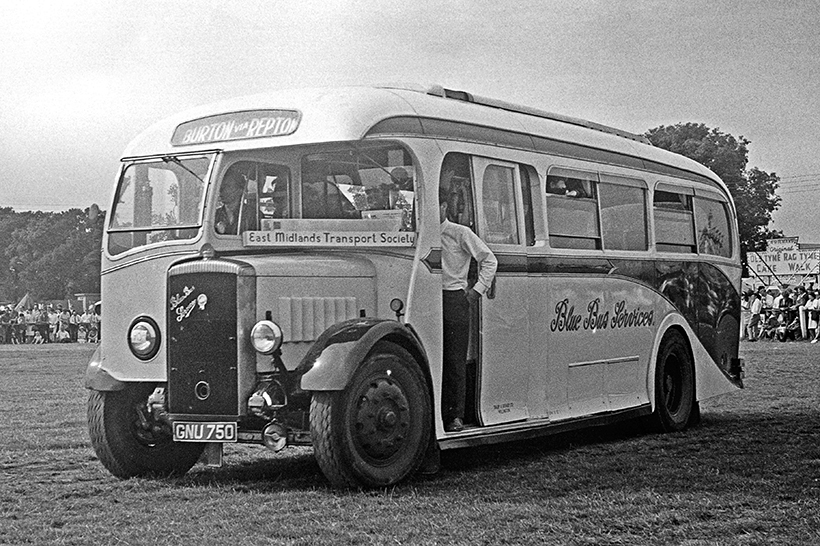
This Daimler COG5/40, with bodywork by Willowbrook, was the final vehicle of this configuration to enter service with Blue Bus Services, and marked the ultimate version of this body design. Its development could be traced by examining earlier saloons owned by this operator. The board mounted diagonally between cab and bulkhead, giving details of the then owner, had originally been used as a destination sign that could be flipped over to indicate the return trip.
I arrived in time for the opening parade and, having observed a variety of steam traction vehicles processing around the arena, I recognised a very familiar vehicle leading another section of exhibits into the ring. I realised that the show had expanded to feature buses and other vintage road vehicles. The familiar vehicle was none other than the ex-Blue Bus Services of Willington Daimler COG5, GNU 750. Having witnessed this excellent example of a pre-war, single-deck, half-cab coach regularly while in service, I delighted in seeing her again in such fine fettle.
Also among the PSVs, a ‘toast-rack’ known in later years as ‘Betty’, received acclaim from the audience. Commencing life as a charabanc in about 1912, the chassis was requisitioned for service in World War I. In 1927, the body emerged from storage, and was mounted on an Austin 20 chassis, on which some extra low gearing made it suitable for working in the hilly terrain that could be found around Sidmouth. It was sold in 1956.
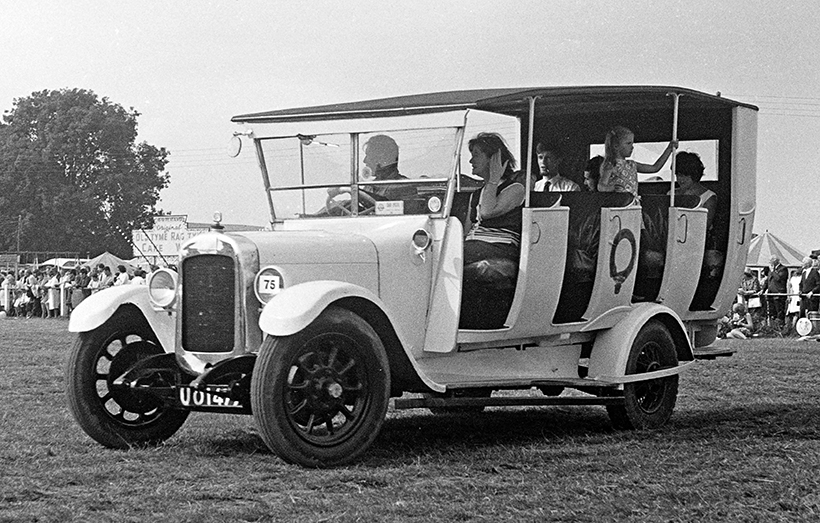
Beginning life as a charabanc in about 1912, records reveal that this ‘toast-rack’ has led an interesting and varied life. Its original chassis being requisitioned for service in World War I, having been stored throughout hostilities, the body was placed on an Austin 20 chassis in 1927. A combination of 3,600cc engine with low-ratio gearbox and smaller rear wheels, made her suitable for work on the steep hills around Sidmouth, where she operated until being sold in 1956. Since appearing at Stafford in 1969, following restoration, ‘Betty’, as she’s now known, has returned to Sidmouth in recent years for private hire duties.
Representing the double-decker, an ex-Birmingham Corporation Daimler COG5 of 1937, with Metro-Cammell body, looked resplendent in her original owner’s blue and cream livery.
Also, representing the Daimler brand, was a Roe-bodied, single-decker COG5/40 of 1940, with a Coventry registration, but wearing the livery of Derby Corporation. This stirred my interest as I had been associated with both cities from the mid-1960s. The only such vehicles in the Coventry fleet at that time was a dwindling number of Daimler CVD6s carrying Brush bodywork, one having been fitted with coach seats for private hire work, while the others handled the route to Berkswell and Balsall Common. The COG5 in question had been sold to Derby Corporation in 1949; spending most of its time on driver training duties. I never witnessed this bus carrying fare-paying passengers.
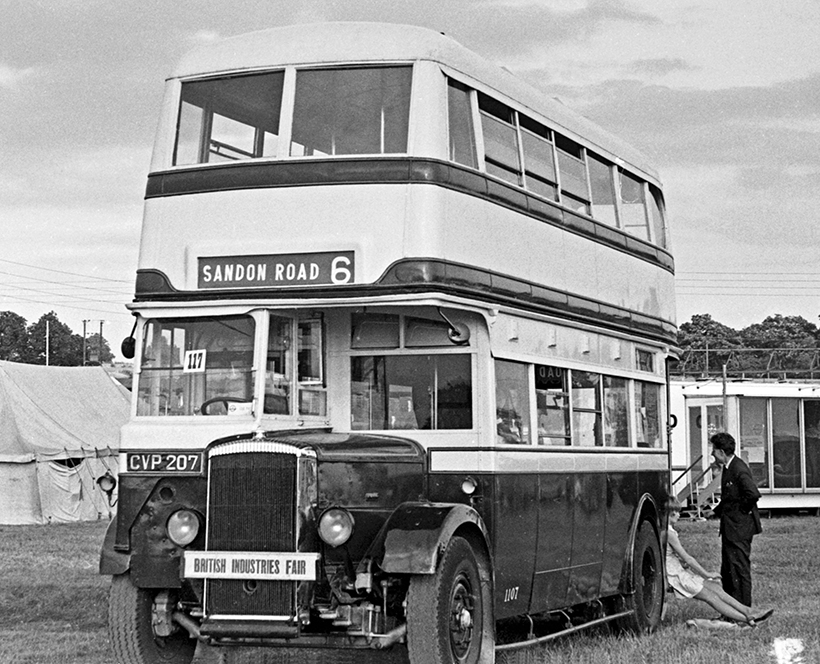
Daimler COG5 with Birmingham-style, Metro-Cammell body, CVP 207 served Birmingham City transport from delivery in 1937. Powered by a Gardner 5LW 7-litre engine with pre-selector gearbox, the bus underwent intensive overhaul during the early 1950s, its original, war-worn body being replaced by one of 1939 vintage. Following disposal in 1959, the Daimler escaped scrapping in 1964, and is now part of the West Midlands Collection at the Transport Museum, Wythall.
The inevitable, Bedford OB completed the line-up that I managed to photograph. On checking details for this luxury coach, I discovered that it had begun life in 1944 as an OWB with a Utility body, not receiving its Duple Vista coachwork until 1952. At the time of the Stafford show, the vehicle remained in commercial service as staff transport.
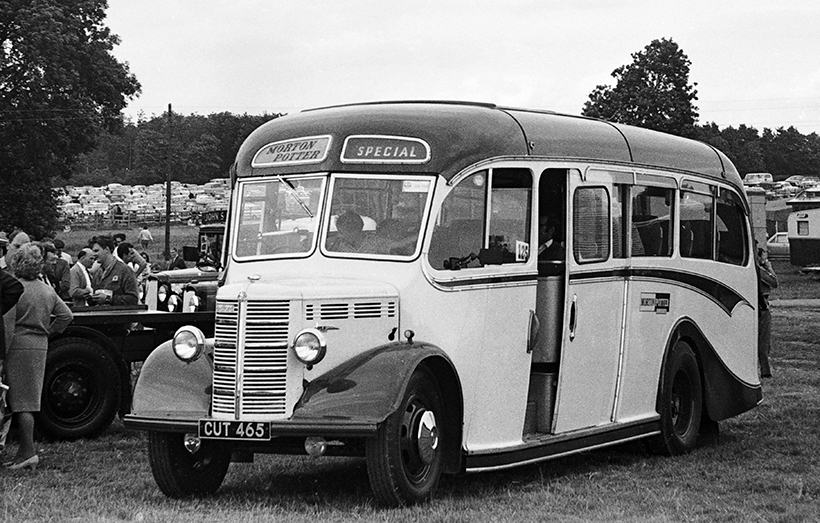
Since retrieving this image of a Bedford OB from my archive, I’ve discovered that CUT 465 dates from World War II, hence the chassis below the luxury Duple body is an ‘OWB’. Like many Utility Bedford OWBs, CUT 465 received a replacement Duple ‘Vista’ body in 1952, two years after OB production had ceased. New to Jacques of Coalville in 1944, the vehicle remained with that operator until 1966, when it became staff transport for civil engineers, Morton Potter. It remained in the contractor’s ownership until preservation in 1974, hence at the time of the Stafford show the coach remained in commercial service.
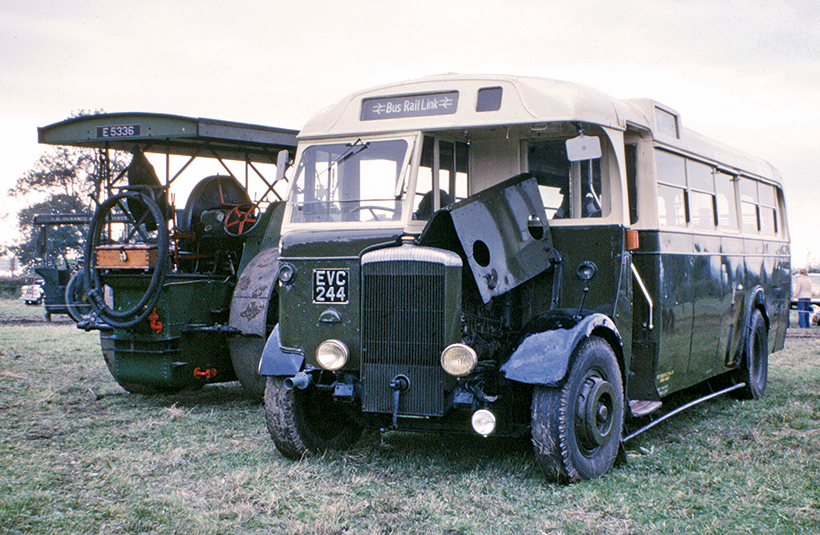
Although having a Coventry registration, this Daimler COG5/40 was seen wearing the livery of Derby Corporation. Supplied new to Coventry Corporation Transport in 1940. With a high capacity, 38-seat Park Royal body, EVC 244 became part of the Derby Corporation fleet in 1949. During the 1960s, when it would have been the only single-decker in the Derby fleet, I observed this bus usually on driver-training duties – certainly never carrying passengers. At the time of the 1969 Stafford rally, records indicate that the Daimler still belonged to Derby Corporation, remaining on the road until 1979. It has more recently been restored in its original, Coventry livery.
To buy a money-saving subscription to Vintage Roadscene magazine, simply click here





